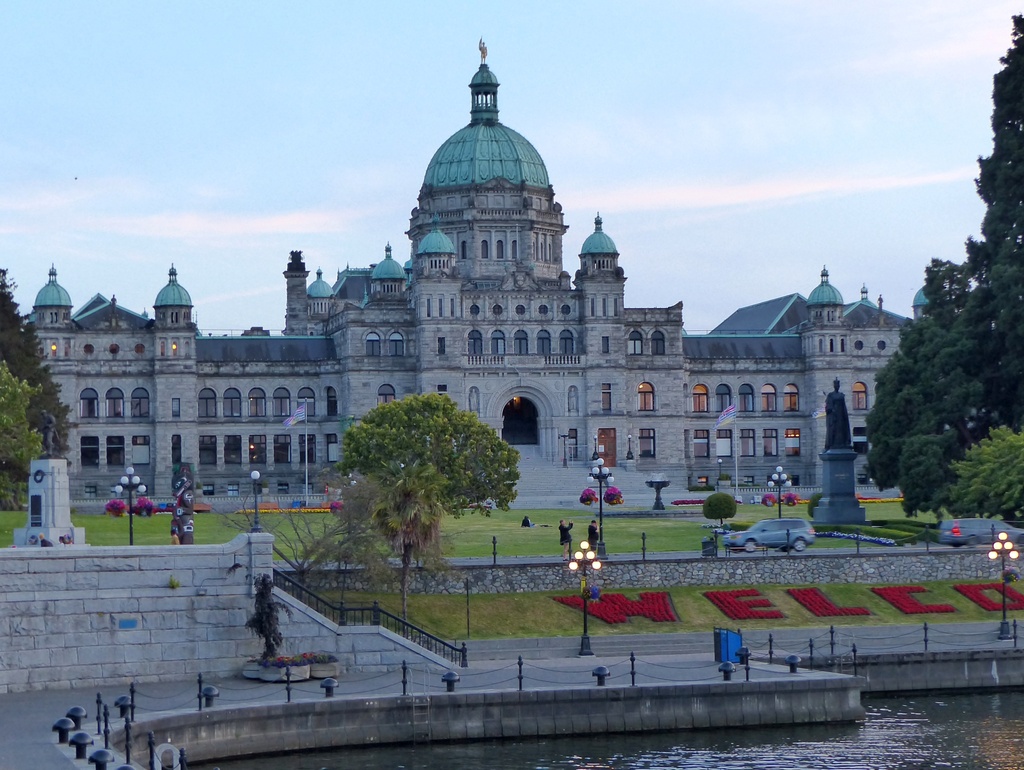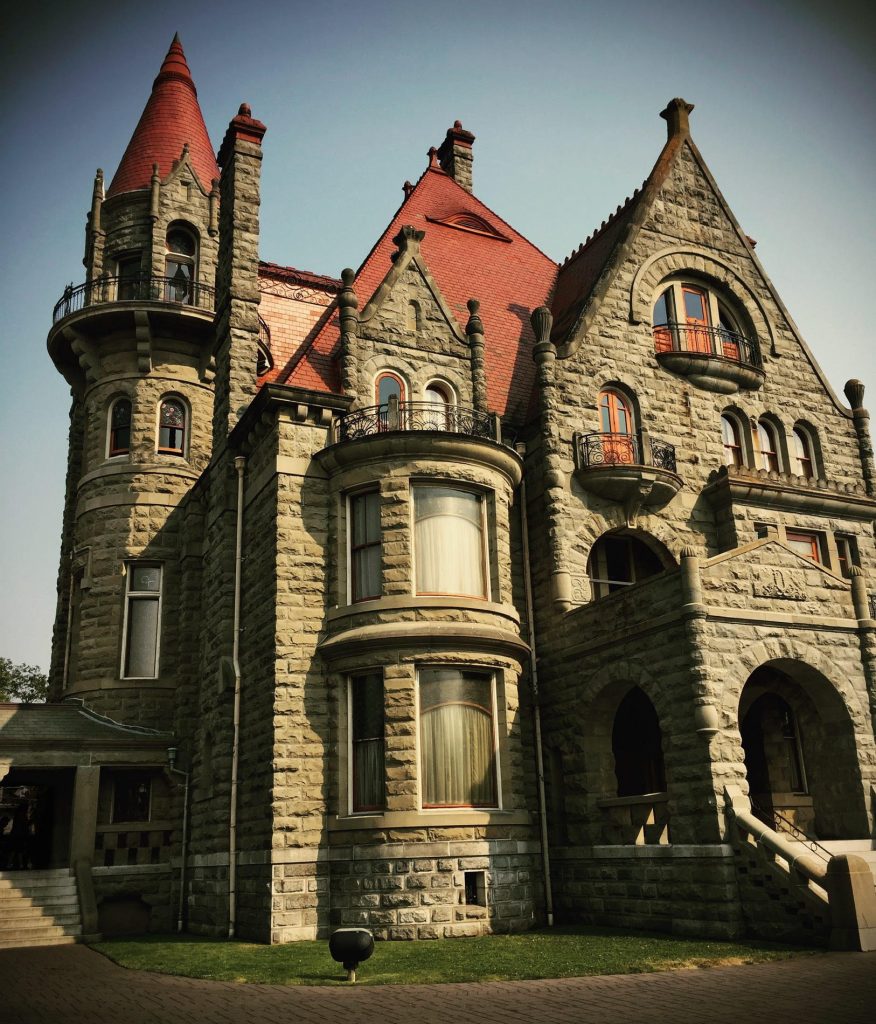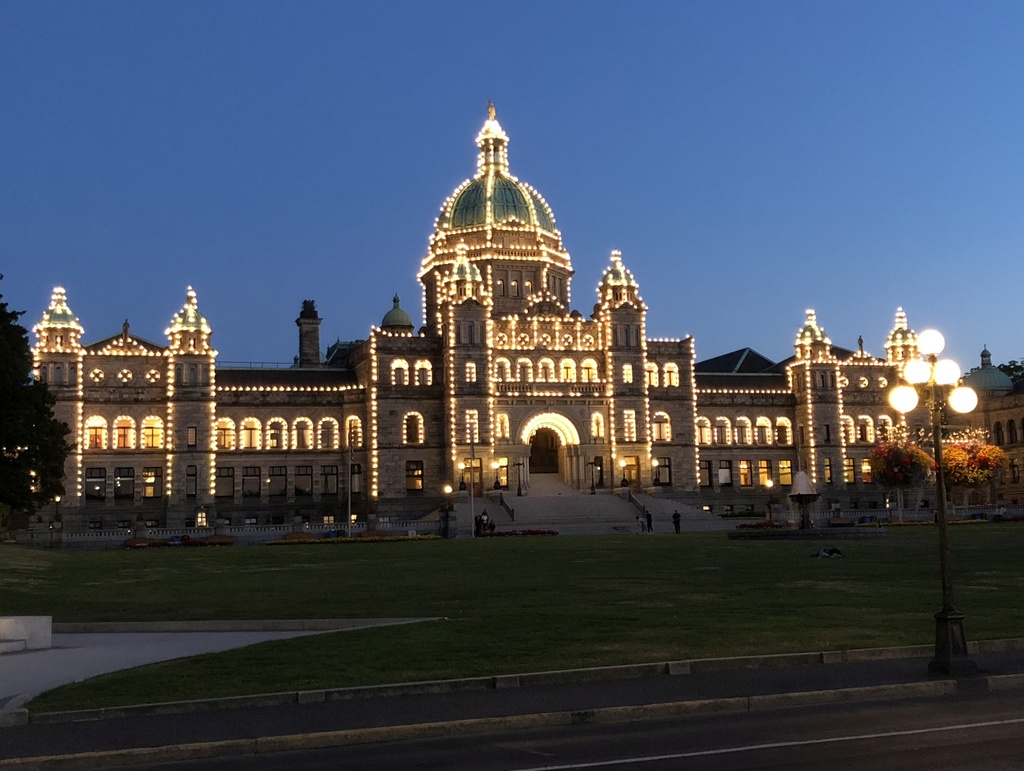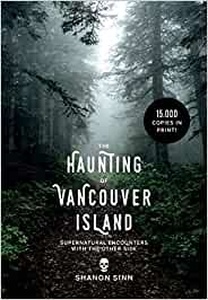By Gina Armstrong, Haunted History BC

Image by Greg Mansfield
If you want to visit a perfect place in British Columbia to dive head-first into history, heritage, and ghosts, Victoria fits the bill. Considered to be one of the most haunted cities in Canada, the province’s capital is home to some of the most architecturally opulent buildings, two magnificent “castles,” and historic streets where phantoms aren’t bashful about making themselves known.
Victoria’s rich and colourful history began with early communities of Indigenous peoples. In the 1800s, British settlers arrived in the area and a lively Chinatown emerged. The iconic Hudson’s Bay Company began its retail story here as a fur-trading post. At its peak, the company controlled the trade throughout most of British North America (Canada’s former name).
Today, historic walking tours and horse-carriage rides are available to those who prefer unique ways to experience the city. Knowledgeable guides give great overviews of Victoria’s history and point out significant landmarks. In and around town, you can visit the Royal BC Museum, Victoria Butterfly Gardens, the stunning Butchart Gardens, and many fantastic pubs and eateries. And the following locations (and more) have a good number of ghosts.
Haunted Places in Victoria
Hatley Castle

Image by Gina Armstrong
Location: 2005 Sooke Road, Victoria, BC
Open: Daily, 10:00am – 4:00pm
Admission: Free
Website: hatleycastle.com
Built in 1908 by Samuel Maclure, Hatley Castle was the grand home of James Dunsmuir, one of British Columbia’s most wealthy and influential men. Dunsmuir was a wealthy industrialist and politician. He served as premier of British Columbia from 1900 to 1902, and as lieutenant governor from 1906 to 1909.
In 1940, the castle and grounds were purchased by the Canadian Government. In gonvernment hands, it was converted it into the Royal Roads Military College. This was a training facility for young officers.
Today, the castle primarily functions as a museum. Guided tours are provided for free. During the tour, which takes about an hour, you can visit several of the spectacular rooms that take you back in time. You’ll see displays of many original artefacts from the days when James Dunsmuir and his wife, Laura, lived in the house with their children and servants. Also, a few rooms have displays that highlight the 55-year period when young men who aspired to have elite military careers lived and trained there.
Some parts of the castle are not accessible, as they’re used by Royal Roads University. The university has occupied part of the building since 1995. But this doesn’t take away from the lovely the atmosphere of this incredible building.
When you tour the exquisite rooms inside the castle, you’re surrounded by rich wood finishings, beautifully carved accents, custom light fixtures, and sterling-silver fittings in the toilets. The rooms are spacious and grand. One of the most magnificent is the mahogany-panelled drawing room, which displays a very ornately carved table and chairs capable of seating up to 24 dinner guests.
Even on the guided tour, you can veer off to take a look at the rooms more closely or take pictures of any ornate features that happen to catch your eye. The museum also educates visitors about the history of local Indigenous people and their use of the land before the looming castle was built. (Royal Roads University gratefully acknowledges that the campus is located on the traditional lands of the Xwsepsum (Esquimalt) and Lekwungen (Songhees) ancestors and families.)
As you take in the grandeur of the building and Hatley Gardens, it’s easy to see why some ghosts from the past linger there.
It’s said that the youngest of James Dunsmuir’s sons, Jim, who eagerly enlisted in the Navy when he was 21 years old, still walks the halls of Hatley Castle and in the picturesque gardens. On his way to war, poor Jim died aboard the RMS Lusitania when it was torpedoed by a German submarine in 1915. His body was never recovered.
James Dunsmuir died shortly after his son, and some believe he died of a broken heart. To this day, staff say they hear odd noises, footsteps, and music coming from what used to be James’ study. Maintenance staff sometimes hear cupboards opening and the eerie sounds of someone pacing back and forth. When they investigate the noises, the room is always empty.
When the military college occupied the building, unexplained noises were reported by various cadets in what was once Jim Dunsmuir’s room. And many of the young trainees refused to sleep in that part of the castle because an old woman would hover over their beds at night or pull their bed covers off. It was believed that this frightening phantom was Laura Dunsmuir. Laura never believed that her son, Jim, had actually died. She always hoped her son would return home some day. It’s thought that Laura was looking for her son among the sleeping cadets. She would go room-to-room trying to find him.
The castle is not the only area graced with spooky activity. Many say they’ve seen Laura’s ghost wandering the stately gardens. And Jim’s apparition has been spotted on the grounds walking up to the castle from a nearby beach.
Regardless of its ghosts, Hatley Castle is simply a stunning place to visit—inside and out. Custodial staff say they’re used to the ‘friendly’ spirits who roam about. They’re no longer surprised when they see an apparition or find that a door or a window has opened and closed on its own. And when phantom period music is heard in the house, it simply adds to the old-world ambience.
Craigdarroch Castle

Image by Victoria Vancek
Location: 1050 Joan Crescent, Victoria, BC
Open: Fridays, Saturdays & Sundays, 10:30am – 3:30pm
Admission: Some charge
Website: thecastle.ca
Craigdarroch Castle was built between 1887 and 1890 for Robert and Joan Dunsmuir. Robert Dunsmuir was a Scottish immigrant who made his fortune in coal mining on Vancouver Island. At the time of the castle’s construction, the Dunsmuirs were the wealthiest people in British Columbia. The home is believed to have cost around $500,000 to build, which is over $15 million in today’s money.
The couple had 2 sons and 8 daughters. Unfortunately, Robert died 17 months before Craigdarroch’s completion and his estate passed to Joan. Upon his death, finishing the home was left up to his two sons, Alexander and James.
After serving as a family estate, Craigdarroch Castle housed a military hospital (1919-1921), Victoria College (1920-1946), the Victoria School Board Office (1946-1968), and the Victoria Conservatory of Music (1969-1979). It was designated as a national historic site in 1992 and now functions as a museum.
Within a pleasant walk from downtown Victoria, Craigdarroch is called a ‘castle’ due to its tall, imposing exterior. Occupying a hill overlooking the city, it’s 4 storeys high and contains 39 rooms. Its luxurious interior has been restored to look as though Robert, Joan, and their children reside there.
Once inside, you’re able to wander around freely and explore the entire castle at your leisure. The self-guided tour takes an hour or two to complete, depending on your pace.
The interior staircase has 87 steps, which lead to an impressive lookout. Because the castle is kept in its original condition, there are no wheelchair-accessible ramps or elevators. So, be prepared to climb lots of stairs and leave kiddies’ strollers behind.
Even though the floor space is vast, at around 20,000 square feet, the interior feels warm and inviting. It’s decorated with luxurious oak panelling, custom tiles, elaborate German woodcarvings, and exquisite furniture and antiques. There’s also stained glass that’s especially striking as you climb the stairs. Light filters in from the long, ornate windows that emphasize the home’s opulent character.
The rooms in the house feel airy and open and perhaps this is why a few ghostly presences stay around. There’s plenty of room for both guests and ghosts!
Staff and visitors have reported seeing the apparition of a little girl inside the castle, as well as the image of a female servant. On an occasion or two, the weird apparition of just a woman’s feet peeking out from under the hem of her skirt have been seen on the staircase.
Guests sometimes report feeling watched or as if someone is following close by as they go about their self-guided tours. Staff and volunteers have reported hearing piano music in the ballroom. The the source of the sound remains a mystery since the castle doesn’t have a piano.
In 2011, a family had a spooky experience while touring Craigdarroch Castle. They were on their way up the grand staircase with their eyes down when one of them looked up and saw a man’s dress pants coming down the stairs. But no feet or shoes could be seen. They all saw this strange apparition before it simply vanished.
In a different part of the building, one of the men in the family group felt a presence near him and saw the man’s trousers again. As he watched, the leggy apparition disappeared behind a partial wall. The family couldn’t wrap their heads around what they’d experienced that day. They could only conclude that they’d seen a ghost.
Whether you want to immerse yourself in history or find proof of spirits, Craigdarroch Castle has it all. It’s a stunning historical mansion with child spirits, ghostly scents of candles burning, cold spots that form randomly, objects moving on their own, and partial apparitions of former occupants strolling down the ornate staircase.
British Columbia Parliament Buildings

Image by Gina Armstrong
Location: 501 Belleville Street, Victoria, BC
Open: Weekdays, 8:30am to 4:30pm
Admission: Free
Website: leg.bc.ca
The British Columbia Parliament Buildings are home to the province’s Legislative Assembly. Construction began on the buildings in 1893 and they were completed in 1897. The buildings officially opened in 1898 and are open on weekdays for public tours. Visitors are sometimes able to watch the parliament’s proceedings from the public gallery.
Originally known as ‘the Birdcages’ due to their overall appearance, the Parliament Buildings dominate the harbourside in downtown Victoria. The 500-foot-wide facade of the Baroque, Romanesque styled structure is a striking monument. This is especially so at night, when 3,500 lights envelope the building in an ethereal glow.
The Parliament Buildings’ majestic interior is reminiscent of old-world English assemblies, with ornate designs, grand, formal seating areas, and impressive beams and columns that showcase cathedral-like ceilings.
The history of the buildings is as fascinating as the story of the man who designed them. The process for finding the architect was an interesting one. A contest was held to find the right person to not only design the buildings but to also oversee their construction.
Francis Rattenbury, a British architect who had emigrated to Victoria, submitted two sets of drawings for the contest. His second drawing, which he titled “For Queen and Crown,” won him the contract. At the time, Rattenbury was only 25 years old.
Rattenbury was very successful in his early career. In addition to the Legislature Buildings, he designed the renowned Empress Hotel in Victoria and the provincial courthouses — now the Vancouver Art Gallery — in downtown Vancouver. Thanks to these successes, he the had means to start several profitable businesses.
After World War I, however, several of Rattenbury’s ventures took take a turn for the worse. And his relationship with his wife, Florence, fell under the strain. He eventually left her and his two children and took up with a much younger and twice-married woman, Alma Pakenham.
Rattenbury’s affair and poor treatment of his family caused such a public scandal that he returned to England with Pakenham in tow. But personal troubles continued to plague him, as it wasn’t long before Pakenham began an affair with their 18-year-old chauffeur, Percy Stoner.
On March 23rd, 1953, Francis Rattenbury was found in a bloody heap in his sitting room. He had been badly beaten and died several days later. Both Pakenham and Stoner were charged with the murder, and she eventually took her own life. Rattenbury was buried in an unmarked grave near his native Bournemouth.
Staff members who work late and alone in the Victoria Parliament Buildings sometimes hear papers rustling, whistling down the halls, echoing footsteps, and odd noises coming from offices as if someone is still working in them. When they call out to or look for the noisy party, there’s no answer and no one is there.
Some volunteers and parliamentary staff also report seeing a shadowy apparition of a man wearing Victorian attire including a top hat in some of the hallways. He’s believed to be the ghost of Francis Rattenbury.
Considering Rattenbury’s dramatic demise, it’s not surprising his ghost chooses to haunt the legislature buildings. Perhaps his spirit enjoys spending time in one of his most spectacular creations. Meanwhile, his architectural legacy in British Columbia endures.
The Empress Hotel

Image by Gina Armstrong
Location: 721 Government Street, Victoria, BC
Open: Daily; certain areas accessible to guests only
Admission: Free; reservations required for accommodations
Website: fairmont.com/empress-victoria
The luxurious Empress Hotel is located in the heart of Victoria, overlooking its stunning harbour. One of the oldest hotels in the city, it’s within a 5-minute walk of the British Columbia Parliament Buildings and the Royal British Columbia Museum.
Built in 1908, this grand old hotel is a National Historic Site of Canada. Over the decades, it has hosted various dignitaries and Hollywood celebrities including Franklin D. Roosevelt, King George VI, Queen Elizabeth II, Rita Hayworth, Katherine Hepburn, Roger Moore, and Shirley Temple.
Like an enormous French chateau, the Empress Hotel is topped with steeply pitched hipped roofs and tall chimneys with decorative caps. Inside, you’ll find Italian marble floors, Tiffany-styled stained-glass windows, and striking domed ceilings.
While the hotel retains its historic feel, its guest rooms have been fully renovated to include air conditioning and other modern amenities. The back of the hotel is attached to the modern Victoria Conference Centre, and offers immaculate spaces for large events, business functions, and weddings.
Afternoon tea in the traditional English style has been served daily at the Empress since the day it opened. This is a must-attend ritual for visitors looking for a sumptuous experience. The spectacular offerings include 21 types of loose-leaf tea along with delicious pastries, scones, and sandwiches. Reservations are required.
The Empress Hotel’s story began when the property was acquired by the Canadian Pacific Railway (CPR) in the early 1900s. In those days, the CPR built many chateau-like hotels in various Canadian cities to accommodate its passengers.
Construction of the Empress started in 1904, and famed architect Francis Rattenbury was in charge of the design. Its architecture displays Rattenbury’s love of the Gothic style.
The hotel has undergone several additions and renovations throughout the years. Additional wings were added on between 1910-1912, as well as additional expansions in the late 1920s. As such, the hallways leading to its guest rooms are lengthy and, in places, maze-like.
With 464 guest rooms and being over 100 years old, it’s no wonder that some ghostly guests and former employees choose to make the Empress their permanent residence.
A regular sighting by both guests and staff is a slender, moustached man who holds a cane. He’s spotted walking on the staircase to the lower lobby and along various hallways. This phantom is said to be the ghost of the architect, Francis Rattenbury, whose scandalous life eventually led to his demise (see British Columbia Parliament Buildings, above). It seems Rattenbury’s spirit returns to haunt both the Empress Hotel and the Parliament Buildings.
Other spooky reports include the ghost of a young girl who is seen in the hallways. The apparition of an employee who took his own life in the hotel’s north-west tower is sometimes spotted there.
A fairly consistent ghostly sighting involves an elderly woman in her night clothes. She’s believed to be a woman who passed away in one of the guest rooms during the 1940s. She knocks on guests’ doors and, looking confused, she asks for help to find her way back to her room. When guests try to assist her, she leads them toward an elevator door before vanishing. (An interesting fact about this is that a guest room actually existed in that location before a service elevator was put in its place!)
The Empress also has a few helpful, ghostly staff members. They include a spectral bellhop and the apparition of a construction worker who both appear on the sixth floor. Also, a phantom maid in old-style uniform is sometimes seen doing her cleaning duties. She apparently plummeted to her death from one of the upper floors while the hotel was undergoing renovations.
Whether you visit the Empress Hotel to soak up some Canadian history, celebrate a special occasion, or to be treated like royalty at afternoon tea, it’s an incredible place to visit. And if you happen to stay on the sixth floor, be sure to tip the courteous but unearthly bellhop on your way out!
Pendray Inn & Tea House

Image by Greg Mansfield
Location: 309 Bellville Street, Victoria, BC
Open: Daily; tearoom open to the public, other areas for paid guests only
Admission: Free; reservations required for accommodations
Website: pendrayinnandteahouse.com
The Pendray Inn & Tea House, also known as the Gatsby Mansion, is a beautiful Queen Anne home. It was built in 1897 by William Joseph Pendray, a prominent Victoria entrepreneur, as the home for him, his wife Amelia, and their four boys.
The inn is very cozy and inviting. With its artisanal craftsmanship inside and out, it offers a glimpse into the elegant past. The interior of the mansion has rich woodwork, Italian stained-glass windows, and crystal chandeliers. Outside, the grounds proudly display William Pendray’s artistic topiaries that used to attract admirers from all over the world.
Originally from Cornwall, England, William Pendray was originally in the mining industry in the United States and Canada. After returning to England as a wealthy young man, he married Amelia. The couple eventually moved to Victoria. William started successful businesses in the soap and paint industries, and purchased the 1.9-acre lot on Bellville Street around 1890 to build his family estate.
All went well for the Pendrays until tragedy struck in 1908. Their eldest son, Ernest, was killed in a freakish horse-and-carriage accident. As he jumped off a carriage that was taking him home an automobile drove by, which spooked the horse. Ernest dodged the horse’s flying hooves and, at the same time, a shaft broke off the carriage. In the commotion, Ernest fell under the carriage just as the second shaft broke. His head was crushed, killing him instantly.
Tragedy struck again in 1913 when William Pendray was the victim of another accident. As he walked through one of his manufacturing plants a loose sprinkler-pipe fell from the ceiling and struck him in the head. He died instantly. He was 68 years old.
As a widow, Amelia Pendray continued to live in her beloved home on Bellville Street and tended its garden well into her later years. She passed away in 1937 at the age of 87.
Today, the inn has nine guest rooms and offers an intimate bed-and-breakfast experience. And anyone is welcome to make reservations in its tea room to experience an authentic and delicious turn-of-the-century English tea.
If you have an appetite for something spooky, the inn purports to have a few phantoms.
Room 5 at the Pendray Inn & Tea Room is notorious for its haunting. Two greenish, glowing heads have been seen hovering above the bed. The heads are thought to be those of William Pendray and his son, Ernest, who both suffered untimely deaths.
Other hauntings at the inn include ghostly voices heard in one of the dining areas and electronic devices turning on and off on their own. On one occasion, a group of guests reported seeing a wine-bottle cork fly through the air past their table when they were in the tea room late one night.
Whether you visit the Pendray Inn for its ghosts, tea room or cozy accommodations, it’s comforting to know that the old house will continue to charm its guests for many years to come. Be sure to drop in to sip some tea while gazing out at its beautiful garden and Victoria’s scenic harbour.
Suggested Reading



